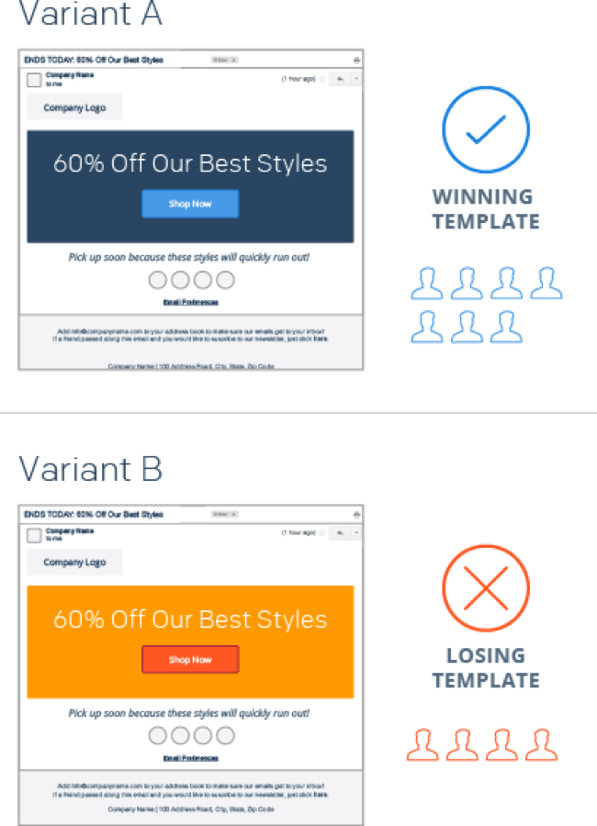Key Differences about Universal Analytics and Google Analytics 4
As you may have known, Google Analytics (usually called Universal Analytics) will no longer be used and be replaced by Google Analytics 4 by July...
%20(1).png)
A call-to-action (CTA) is a button on your website that you use to entice a website visitor to a different webpage or to a form where they can convert and become leads in your database. They can be both on-page or via a pop up.
Calls to action are an essential part of your website and marketing strategy. They help you move visitors from content to content, and if you’ve mapped your CTAs to your ideal customer journey, further down your funnel.
In this guide, we’ll explain more about the types of website calls to action, how you can get more people clicking them and what you need to do next if they do.
With more and more websites competing for your target market’s attention, the cost of advertising increasing and search engines changing their ranking algorithms regularly, it’s incredibly hard to get traffic to your website. So when you land a website visitor it’s important to keep them on your website longer — or even better — capture their details to nurture them later.
Let’s look at the two goals above and some calls to action that will help us meet that goal.

Call to Action Examples: Viral Loops
If your pages are written with search rankings in mind and optimised well, you should get highly qualified traffic that lands on the most relevant webpage for them first time, but some traffic sources (like referrals, social media and more) direct leads to your homepage. To encourage these types of visitors to spend more time on your website and visit a conversion page, it’s important to use calls to action to entice them to visit more pages.
Calls to action to keep visitors on your site longer include:
The calls to action could link to your blog, pillar pages, industry pages, role-based buyer persona pages and gated assets (more on those below).
If you can capture the details of the website visitor, you can use those details for any number of follow-up nurture marketing activities. For example, when a lead has downloaded an eBook or a guide you’ve created, you can send them an automated email sequence to warm them up and get them closer to a buying decision.
If you include specific questions on your form that are relevant to your buyer personas, you can then use the information provided up front to send personalised and targeted nurture campaigns. For example, send each industry different follow-up resources or case studies. Internally, you can also direct these leads to the most suitable sales rep.
So what’s going to make your website visitors click on a CTA?
It’s the offer. Make sure you’re providing value to your website visitors. After all, they’re giving you their email address and business information, they expect value in return. What’s valuable depends on your audience, but we recommend giving away some of your most valuable knowledge to earn their trust.
This could be:
In addition to being compelling, calls to action also have to be visually enticing. Next, we’ll cover some tips and tricks for making your calls to action stand out.

(Call to Action Example: Dropbox)
Remember the comments we made about how hard it was to compete for attention on social media and search engines? The same can be said for webpages. The mind is constantly removing distractions (and other unimportant information) on our behalf — otherwise we’d all be constantly overstimulated.
Therefore, your calls to action need to grab and hold your website visitor’s attention in a short amount of time — and you only really have the design and the words to rely on. Here’s how you can start creating more compelling calls to action:
Contrast: Website visitors notice and pay attention to things that contrast. That’s why every website in the world has different button colours to their background colour. Colour actually plays a significant role in call to action performance, for example, many websites use green buttons because it means ‘go’ in most languages.
Emotion: Most people don’t read. They scan. You can play to that by using emotion, questions and unexpected language. For example, “See what you’re missing out on”, “Want to process payroll in a single click?”.
Personalisation: It should come as no surprise that most people are drawn to their own name. Marketers have known this for some time. That’s why your first name appears in so many subject lines. For personalisation to work, you’ll need the website visitor’s details first, so save personalised calls to action for returning lead. In addition to first name, you could also use company name and any other information you’ve already collected from your leads.
Design: A pleasing design and frictionless user experience can do wonders for your calls to action. Try different colours, different fonts, different images and different directional cues. For example, accompany your calls to action with an arrow pointing to the button or if you’re using photography, get the subject looking at the call to action.
Novelty: If all else fails just get a giant shark to hold the call to action button in their teeth. Humans like new stuff and that example is just that.
Clarity: We’re firm believers that you should say your website visitors’ expectations upfront. Tell them exactly what they can expect if they click on the call to action. For example, “sign up to improve your site’s speed, in just ten minutes, without code”.

(Call to Action Example: Blue Apron)
When you’ve created the content behind your calls to action, written then and designed them, it’s time to test them. Most website content management systems and marketing automation tools allow you to split test buttons by serving two versions of your call to action and helping you identify a winner.
As with all split tests, you’ll only want to change one variable at a time. Accordingly, try changing the copy first, then on the next test, change the colour and so on. Incremental improvements to conversion rates mean more leads and more customers.
Different ways of split testing your calls to action include:

If you’re already confident with your call to action knowledge and performance, consider taking your calls to action to the next level with dynamic calls to action that change depending on your visitor’s location and characteristics.
Dynamic calls to action allow you to display personalised experiences; helping you to outline the ideal next step in your visitor’s conversion journey no matter where they are in your funnel or decision-making process.
Let’s check out an example:
HubSpot and most other marketing automation tools will allow you to personalise your calls to action based on a visitor’s location, device, referral source, or other property if they’re returning leads ( lifecycles stage, industry etc.).
If you display the most relevant call to action to your website visitors and leads, you’re more likely to get conversions. Therefore, we recommend you’re displaying dynamic calls to action that are mapped to your buyer’s journey to help move leads further down the funnel.
To do that, you need to map out your typical buyer’s journey. A good place to start is getting into the mind of your buyer persona and consider the pain points they’re looking to solve, the content they’re likely to interact with and the way they prefer to research and buy. Then consider how your website might help them in that journey and how your expertise can expediate the process of converting (i.e. getting in touch with you).
You can also use Google Analytics data, customer interviews and any other tool you use to measure marketing effectiveness (hotjar, marketing automation) to help you map out the most common journey.

A call to action acts as a signal to your website visitors, it tells them what to do next. Without clear and compelling calls to action advising them what action to take next, it is likely they’ll leave your site, or if they’re existing leads, they may never get closer to a purchase decision.
Whether you use on-page calls to action at the bottom of your content, content upgrade offers, header navigation calls to action, pop ups or others, it’s important to pay close attention to your buyer personas, map your calls to action to the ideal journey — and of course constantly refine and test your calls to action for maximum conversion.

As you may have known, Google Analytics (usually called Universal Analytics) will no longer be used and be replaced by Google Analytics 4 by July...
%20(1).png)
Businesses are increasingly moving online to expand their reach and provide the best possible experience to their customers. Being online, however,...

Running an e-commerce store means juggling product launches, abandoned carts, upsells, emails, and more. These marketing automation tools help online...